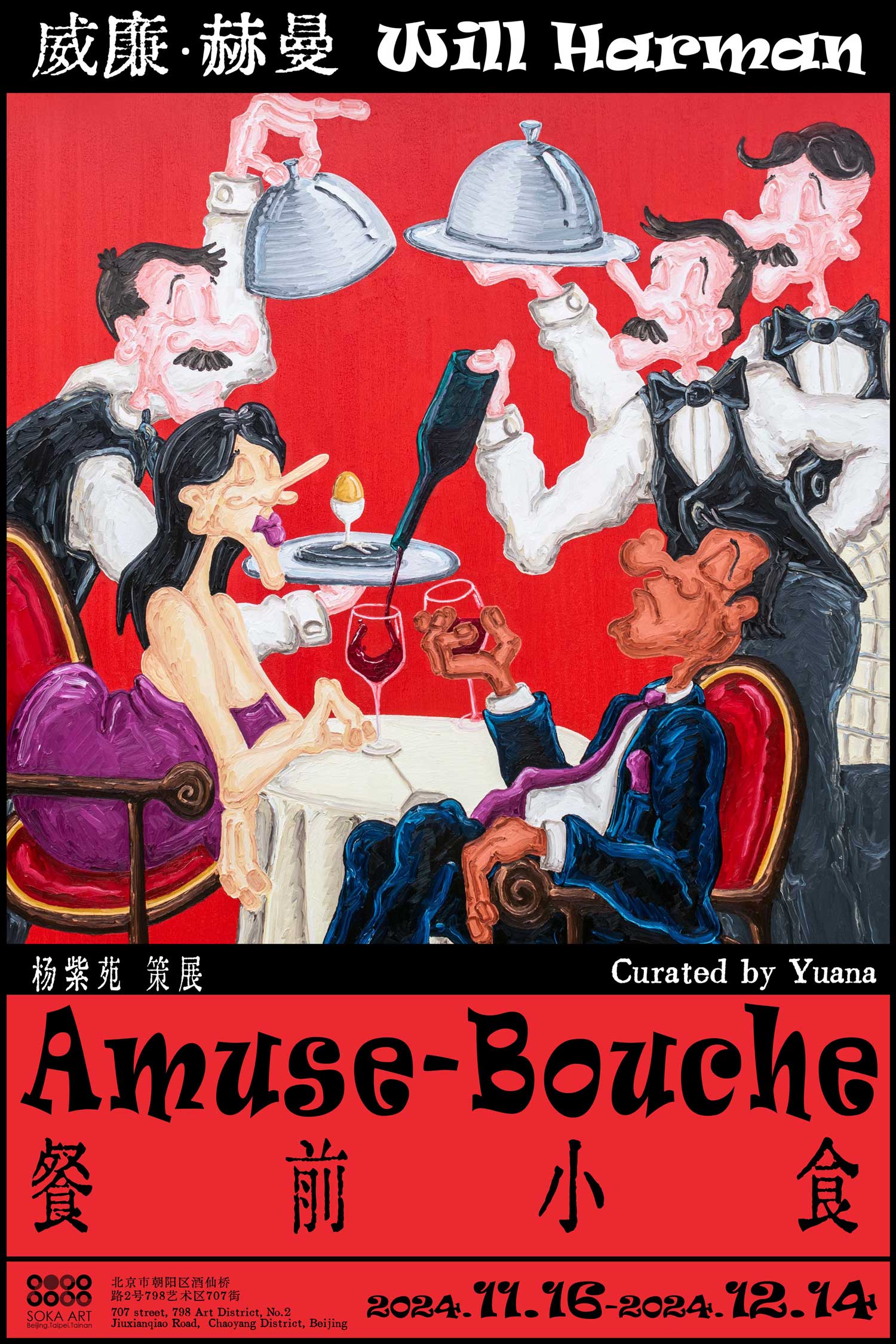Soka Art is pleased to announce that British artist William Harman’s solo exhibitionAmuse–Bouchewill be presented at Soka Art Beijing Space on November 16, 2024, featuring fourteen new paintings, this exhibition is William Harman's second solo exhibition in China after his solo exhibitionFreedom From The Suburbs in Soka Tainan in 2023. The works are drawn from his familiar surrounding areas to more new environments and settings, further unpicking the artist's personal relationship to Britishness. The exhibition is curated by Yuana and will last until December 14, 2024.
Amuse-Bouche is a French word that directly translates to “mouth amuser”, which refers to the appetizers offered to guests before the main course is served in Western culinary culture, with the purpose of bringing some amusement and fun to the diners waiting for the main course. Each of Will's works is like an Amuse-Bouche, which makes the audience happy, surprised or frowned, each “bite” is anything but bland. The bold use of colors and exaggerated facial expressions of characters enhance the visual tension in a "comic-like" way, making the work more popular and entertaining. The uniform square size of the canvas makes the work look like a cut picture, focusing on the small corners in the large venue, infinitely magnifying the dramatic conflict and arousing the audience's imagination of the scene outside the canvas, also projecting and reflecting on their own social role roles.
“Each of my paintings is poking fun at the way we perceive each other, British customs, class structures, contemporary affairs and pastimes.”
This series of works by Will Harman can be seen as his memoir diary of the past year, recording events such as football matches or horse races, or fights and protests in the context of social and political divisions and scandals. Will depicts the real world in his eyes based on the images in the news and his own experiences, which is a direct response to his life or what he saw that day.
The Group of self-proclaimed “defenders of the realm” wearing headscarves and crosses and took to the streets for so-called peaceful protests, but often ended in violent conflicts caused by alcohol; The ladies who dressed up to go out on “Ladies Day” would be drunk and “lose their elegance” at the end of the celebration and stumble home; “Lazy River” intended to get close to nature is just a place for people to have fun, the beautiful scenery in the river became a foil for cigarettes and alcohol. These moralistic group activities start with a serious appearance and always end dramatically with farce, so absurd, but so in line with the reality of the world. After all, there is no simple right or wrong inany of this, because humans always seem to rationalize everything they do.
Will Harman takes the idea of the “pantomime of collective experience” as a clue in his work, although the paintings cover a wide range of narratives, some of which may involve more serious topics such as social divisions and political scandals, they are all wrapped up in Will’s unique sense of humor, which does not makeviewers feel overly radical but sympathize with the diversity and unpredictability of life. For example, the work Hors D’oeuvres depicts an upper-class couple nobly served by three waiters in a fine dining restaurant, with a flow of wines, and a seemingly simple golden egg for the main course, but it's easy to see how the meal could be quite expensive. The painting draws on references from the social satire of James Gillray (British 19th C caricaturists), Fawlty Towers (a 1970s British sitcom about a dysfunctional hotel), and the story of The Goose that Laid the Golden Egg from Aesop’s Fables. The three works have different carriers, but all have the same core. In this painting, Will contemplates “how ordinary things are elevated to the point of deviating from their original nature”. As people move through different environments, the cultural capital of a thing rises and falls, and its class signifier changes. Like the humble egg, usually a breakfast staple, it becomes a commodity when it is served at a local cafe, and when it is served on an exquisite silver platter at a Michelin restaurant, it is upgraded to a high-dollar commodity that comes with attentive service. It is all about class, status and symbols, and the “golden egg” is a symbol of greed and excess. As the saying goes, desire can never be filled. Will Harman's work exposes metaphors of reality that grow and twine endlessly like a vine connecting human desires.

